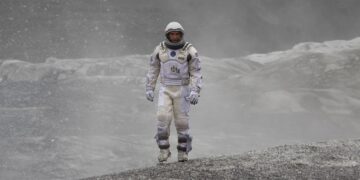On March 7, 1999, when Stanley Kubrick died at the age of 70 on his huge country estate in the English countryside (Harpenden, Hertfordshire/UK), he left behind a moderate work of 13 full-length feature films, but a reputation between genius and madness that could not be more turgid. While Kubrick, who never left England in the last 40 years of his life (he feared flying, even though he had a pilot’s license and was passionate about airplanes), always relied on literary models, he was deeply obsessed with images.
He was a fanatical photographer who wished to make silent films from the novels and novellas of Arthur C. Clarke, Vladimir Nabokov, Stephen King or Arthur Schnitzler, in any case with as little dialogue as possible. But pictures, built like architecture: strict, constructed, logically built and often beautiful – but also cold and with only very few, hidden points, where the emotions can start.
In the words of one critic, Kubrick films are indeed like perfectly arranged museum exhibitions, a celebration for the mind and the eye, but little for the soul. As a matter of fact, all of Kubrick’s characters are emotionally detached, down to the worst nightmare. Throughout his life, Stanley Kubrick denied his audience cinema as the epicenter of great emotions.
The Best Stanley Kubrick Movies
Stanley Kubrick has earned an incomparable reputation with only 13 feature films in 46 years. After his death of about a week after the first screening of the final cut of “Eyes Wide Shut”, no necrology remained without mention of his perfectionism, driving him at times to repeat scenes countless times and driving collaborators mad. Kubrick interfered everywhere, even in dictating the terms of translation in other countries.
His urge to make everything perfect – as numerous interviews of his actors and collaborators confirm – was also a great burden for many on the set. In the following, we will take a look at some of the best Stanley Kubrick movies that he created during his life.
Barry Lyndon (1975)
- Original title: Barry Lyndon
- IMDb rating: 8,1/10
An unfortunate love affair is Redmond Barry’s (Ryan O’Neal) undoing in 1750s Ireland: the young man falls in love with his cousin and in a duel shoots his rival. Not suspecting that the duel was faked and that his cowardly rival was alive and well, he escapes and enlists in the English army during the Seven Years’ War. However, he soon has enough of the soldier’s life and deserts.
With false papers on the way to Holland, he is forcefully recruited as a spy by the Prussian officer Potzdorf. However, Redmond disobeys the order and prefers to work as a master of gambling. Winner of four Oscars, this long underrated costume drama about the rise and fall of an Irish upstart in which director Stanley Kubrick also celebrates the beauty of Baroque painting and music.
Spartacus (1960)
- Original title: Spartacus
- IMDb rating: 7,9/10
During the 1st century BC. the Roman Batiatus (Peter Ustinov) saves the slave Spartacus (Kirk Douglas), who was sentenced to death for sedition, from execution because he wants him for his gladiator school. There, hard training and humiliations are everyday life. Spartacus, after a fight to the death in front of the decadent praetor Crassus (Laurence Olivier), starts a revolt against the powerful Roman Empire. Awesome crowd scenes and social portrait of Roman times including homoerotic innuendos – a huge scandal in its day. Four Oscars!
Killers Kiss (1955)
- Original title: Killers Kiss
- IMDb rating: 6.6/10
Davey Gordon is a failed boxer with most of his career already behind him. He cannot afford more than a very modest apartment in New York. Living across the street from him is the beautiful Gloria, working as a dancer in a seedy dance club. That club is owned by Vincent Rapallo, who is an aging gangster who keeps Gloria oppressed and dependent.
When he discovers that Davey has fallen in love with Gloria, he tries everything to break up their relationship. Following a failed assassination attempt on Davey, he even has Gloria kidnapped in the end. So Davey tries to free Gloria from Rapallo’s hands once and for all. This leads to a dangerous duel between the rivals in an abandoned mannequin factory…
The Killing (1956)
- Original title: The Killing
- IMDb rating: 8,0/10
Having barely been released from Alcatraz, Johnny Clay is planning the next big thing: with the help of four criminal amateurs, he intends to rob the most important racetrack in the country. Everything goes according to plan at first. But since each of the parties involved has its own motives and goals for the coup, everything – portrayed from different perspectives – inevitably leads to a catastrophe.
A finger exercise between noir and heist movie, with Sterling Hayden perfectly cast, whose chronologically nested narrative (the screenplay was written by Kubrick with Hard Boiled legend Jim Thompson) had a lasting influence not only on the cinema of Quentin Tarantino.
Lolita (1962)
- Original title: Lolita
- IMDb rating: 7.6/10
The first movie that Kubrick, born in New York, produced in his new adopted country, England. At that time controversial, the literary adaptation is more and more admired with age. Synopsis: Novelist Humbert Humbert (James Mason) rents a room in a small American seaside resort for the summer months. However, when he falls in love with the underage daughter (Sue Lyon) of his bitter landlady (Shelley Winters), his life is thrown completely off course.
Helpless, he is dragged into the destructive maelstrom of an absurd passion… The movie begins as a pitch-black social satire and ends as an oppressive, tragic farce. Under the direction of Stanley Kubrick, a sensitive, moving character study was created – based on a screenplay by Vladimir Nabokov.
Eyes Wide Shut (1999)
- Original title: Eyes Wide Shut
- IMDb rating: 7.4/10
From the moment his beautiful wife Alice (Nicole Kidman) admitted her sex fantasies with a naval officer to him at a drug-fueled party, young doctor William (Tom Cruise) is totally off the rails. So he wanders the streets of New York on the night of the millennium and thereby stumbles into both bizarre and tragicomic situations with various women who incite his desire.
In the end, William even gets lost into a secret sadomasochistic party. This is a disturbingly complex erotic drama about love, lust and fear of death. What is and remains great directorial art is the way the emotional life of a couple is explored down to the darkest corners!
A Clockwork Orange (1971)
- Original title: A Clockwork Orange
- IMDb rating: 8.3/10
Alex (Malcolm McDowell) is the ultra-violent boss of a youth gang in a utopian alienated London. He is arrested and convicted after a murder. With the prospect of getting out of prison sooner, he volunteers to be brainwashed and – “cured” and unable to fight back – falls into the hands of former victims … A savage and hard-to-decipher nightmare staged by director genius Stanley Kubrick, based on the novel by Anthony Burgess.
Paths of Glory (1957)
- Original title: Paths of Glory
- IMDb rating: 8.4/10
Following a failed attack on a German position, French General Mireau plans to have three soldiers shot for cowardice in the face of the enemy. Colonel Dax (Kirk Douglas), a lawyer in civilian life, is desperate to save the men from the inhumane order. In front of the court martial, the decisive confrontation takes place. Ruthless indictment of the crime of war. This Kubrick classic was banned in France, Spain and Switzerland.
Full Metal Jacket (1987)
- Original title: Full Metal Jacket
- IMDb rating: 8.3/10
It is 1968: Parris Island in Beaufort, South Carolina, is the location of basic training for U.S. Marine Corps recruits. This is where they are drilled to become tough fighting machines for their deployment in Vietnam. In charge is the merciless Gunnery Sergeant Hartman (Lee Erney), who bullies the soldiers to the point of blood and breaks their will. They include Privates Joker (Matthew Modine), Paula (Vincent D’Onofrio) and Cowboy (Arliss Howard).
As the former succumbs to martyrdom, the mentally unstable Private Paula is a sitting duck for the sadistic instructor. This is an incredibly intense, shocking and gripping cult film that unsparingly portrays the reality of war without moralizing. Director Stanley Kubrick’s penultimate work.
Dr. Strangelove or: How I Learned to Love the Bomb (1964)
- Original title: Dr. Strangelove or how I learned to stop worrying and love the bomb
- IMDb rating: 8.4/10
In the peak of the Cold War, US General Jack D. Ripper (Sterling Hayden) freaks out and launches a nuclear attack against the USSR. With US President Muffley (Peter Sellers) desperately trying to avoid catastrophe at the last minute, obscure scientist Dr. Strange (also Sellers) is dreaming of creating a master race that could survive nuclear war. A bitter, pitch-black satire by Stanley Kubrick in the shadow of the Cuban Missile Crisis in 1962, when there wasn’t much short of global nuclear war. Four Oscar nominations.
2001: A Space Odyssey (1968)
- Original title: 2001: A Space Odyssey
- IMDb rating: 8.3/10
It almost belongs to the general education to have seen the philosphical Kubrick feat. In the beginning, the film introduces us to a group of pre-humans who discover the tool, as well as kill one of their own. Then one day, a black monolith stands in their midst. Jump to 1999, where the astronauts find the same stone on the moon. On a mission to Jupiter 18 months later, supercomputer HAL detects feelings and resists its elimination. The use of music (Also sprach Zarathustra, Donauwalzer) is unforgettable. Timeless-genius masterpiece!
The Shining (1980)
- Original title: The Shining
- IMDb rating: 8.4 / 10
The writer Jack (Jack Nicholson) accepts the position of caretaker in a mountain hotel in Colorado, which is vacant during the winter. This family man sees it as the perfect opportunity to finish his novel in peace. Even his wife Wendy (Shelley Duvall) is looking forward to the time in solitude. It is only his six-year-old son Danny (Danny Lloyd) who has doubts. After all, since moving in, he has been haunted by dark and bloody visions.
This is when Papa Jack starts acting stranger and stranger. The boy’s tricycle rides, the crazed grinning Jack Nicholson with a pickaxe, or the moment Shelley Duvall recognizes what her husband has really been putting down on paper all along: Kubrick’s only excursion into the horror genre has some movie scenes to last forever!

